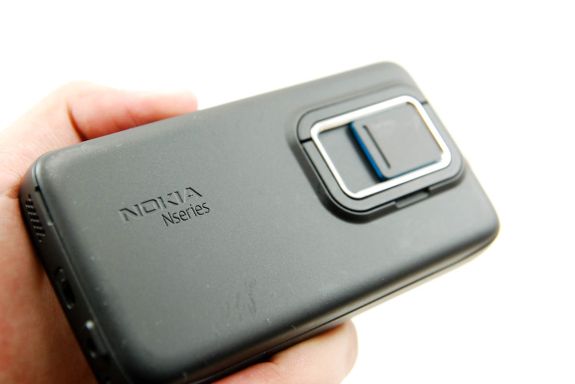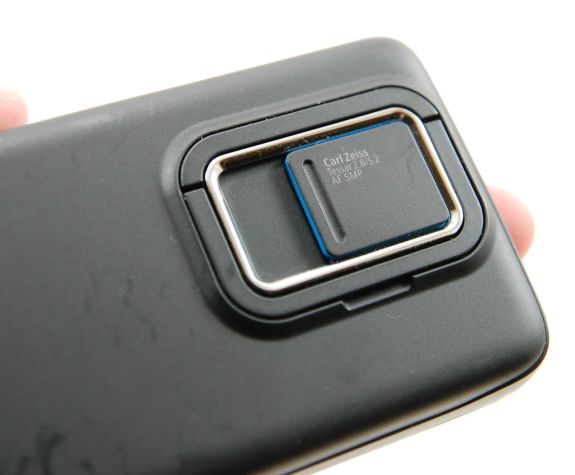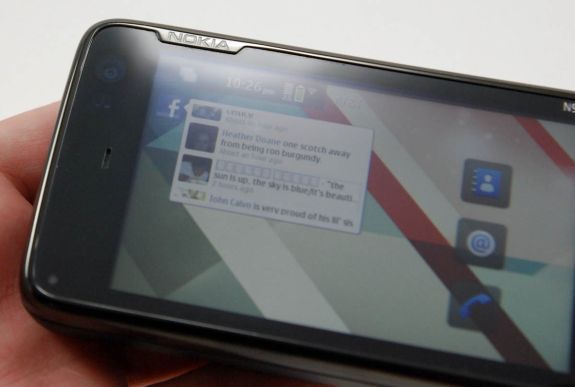Two OMAP 3430 Phones: Nokia N900 and Motorola Droid
by Brian Klug on June 10, 2010 9:29 PM EST- Posted in
- Smartphones
- N900
- Maemo
- Motorola Droid
- Droid
- MeeGo
- Android
- Mobile
The entire backside of the N900 is the removable battery, SIM, and microSD slot cover. It snaps on and snaps off; there's no sliding mechanism, just a small place to get your fingernail under and pry the whole thing off with. That isn't to say that the back isn't snug, it's just a bit unnerving to rip the back off the N900 the first time, but that's really how you do it.
It's also on the back that the sliding camera cover and integrated kickstand reside. The kickstand isn't perfect; since it's off-center if you put the phone down in landscape mode as intended there's a bit of a tendency for the device to tripod on the other side if you tap on the screen. It's clear that this is really meant as an aide to viewing videos, say on a transatlantic flight.
On the front is the resistive topped 800x480 3.5 inch LCD, and up at the very top in the center is the small speaker not much bigger than a grain of rice for making phone calls. I was a bit worried at first that volume would suffer, but it's on par with every other handset I've used. Off to the right of that is the front-facing VGA camera, and on the far left side is the IR proximity sensor.














68 Comments
View All Comments
DaveGirard - Saturday, June 12, 2010 - link
sweet Jesus, that Nokia phone is huge. Does it double as an ice cream sandwich cover?metafor - Sunday, June 13, 2010 - link
Cortex is the CPU designed by ARM. This is available as a hard-macro (layout already done) or soft-macro (just the functional RTL). Some companies license this in either version. For those who license the soft-version, such as TI, nVidia and Broadcom, they can do a customized place-and-route along with clock-tree optimizations and voltage partitioning to try to make the design run faster.However, the micro-architecture is the same.
A few companies have ARM architectural licenses (Apple, Qualcomm, Marvell) and instead of licensing the Cortex line of processors, they design their own. The micro-architecture is developed independent of what ARM did in their Cortex series albeit there will often be similarities.
Scorpion inside Snapdragon was developed in the course of years and while it has many similarities to the A8 from a power-point standpoint, the micro-architecture underneath was designed from the ground up. Everything from the branch predictors, the cache controller, exception handling, execution units and most notably, a partially OoOE scheduler and retirement buffer.
There's also the 128-bit, fully pipelined, partially OoOE SIMD/FP unit.
medi01 - Sunday, June 13, 2010 - link
Well, I find it very strange, that "incidentally" iPhone is never shown in bad light. Could you please update your side to side comparison?Impulses - Wednesday, June 16, 2010 - link
Personally I think there's better things for you guys to do or test with your time... Who cares if a phone's screen colors are more or less accurate, as long as they aren't outright flawed or ugly to look at it shouldn't be a big deal, not like anyone's gonna be doing any pro content editing work on their phones! (I don't even own an AMOLED screen so I'm not particularly biased one way or the other, I own an EVO atm)mojtabaalemi - Saturday, June 19, 2010 - link
I hate the design of nokia mobile phones . in my idea an iphone is far far better !paihuaizhe - Sunday, June 20, 2010 - link
(nike-alliance).(com)=>is a leading worldwide wholesaler company (or u can sayorganization)
arnavvdesai - Saturday, June 26, 2010 - link
I was just wondering if the author had installed AdBlock+ and then run the browser speed numbers or without it being on. If it was not installed which is what I am guessing from the photos, did you notice an improvement in the render times when it was installed. I actually bought the phone recently after seeing it on sale for 380$ and wanted to know the details. Also, I have heard that the current build of the OS allows potrait mode even for the browser(although it has to be activate through some setting) and not just the phone.drwiremore - Sunday, July 4, 2010 - link
Amanda, delighted to have found you. Given the issues in the title, affecting 20~50% of MOTO Droid users, was surprised to see no mention of it. The MOTO boards are alive with disdain and some feel an in you face attitude by Motorola Droid 2 and X announcements. Would you do an iPhone like analysis of voice, antenna and signal issues across Verizons Droids: HTC incredible and MOTO Droid. Your scientific analysis would be welcomed.